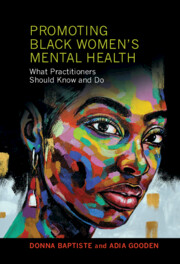Book contents
- Promoting Black Women’s Mental Health
- Promoting Black Women’s Mental Health
- Copyright page
- Contents
- Figures
- Tables
- Contributors
- Introduction
- Part I Black Women in Context
- Part II Therapy Contexts
- Part III Core Themes in Black Women’s Stress and Distress
- Part IV Helping Black Women Recover and Thrive
- 13 Improving Black Women’s Physical Health and Wellness
- 14 Black Women’s Inner Healing and Resources for Thriving
- 15 Black Women’s Spiritual and Religious Coping
- Conclusion
- Appendix
- Index
- References
13 - Improving Black Women’s Physical Health and Wellness
from Part IV - Helping Black Women Recover and Thrive
Published online by Cambridge University Press: 22 June 2023
- Promoting Black Women’s Mental Health
- Promoting Black Women’s Mental Health
- Copyright page
- Contents
- Figures
- Tables
- Contributors
- Introduction
- Part I Black Women in Context
- Part II Therapy Contexts
- Part III Core Themes in Black Women’s Stress and Distress
- Part IV Helping Black Women Recover and Thrive
- 13 Improving Black Women’s Physical Health and Wellness
- 14 Black Women’s Inner Healing and Resources for Thriving
- 15 Black Women’s Spiritual and Religious Coping
- Conclusion
- Appendix
- Index
- References
Summary
Black women suffer from higher mortality rates and experience heart disease, breast cancer, and other health issues at different levels than White women. Additionally, Black women commonly experience somatic symptoms related to mental health issues, and therapists can help women understand and address the connection between their physical and psychological health and wellness. In this chapter, we offer suggestions and tools to help therapists raise women’s health literacy, their awareness about mind–emotion–body connections, and provide strategies Black women can use for stress management to improve physical and mental wellness.
- Type
- Chapter
- Information
- Promoting Black Women's Mental HealthWhat Practitioners Should Know and Do, pp. 311 - 335Publisher: Cambridge University PressPrint publication year: 2023



